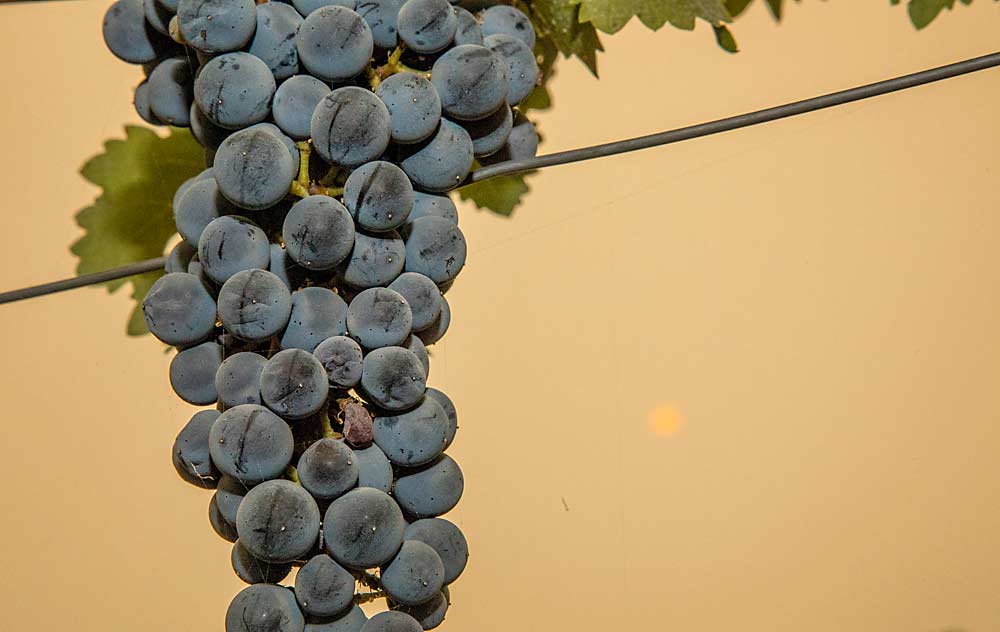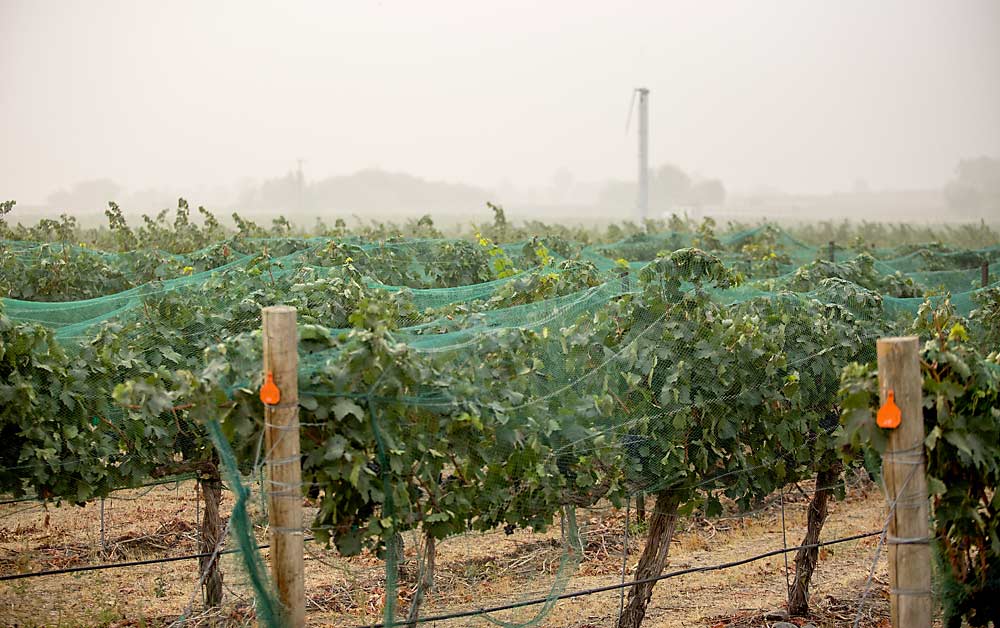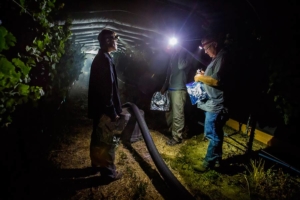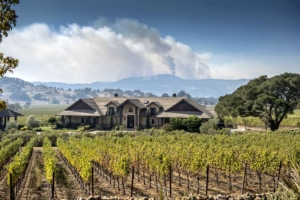
When wildfire smoke from the dozens of deadly, destructive blazes blanketed the West Coast in the midst of harvest in September, many in the wine industry looked at the hazardous air quality with trepidation.
Smoke-exposed grapes can result in ashy, unpalatable wines with off flavors that emerge over time. But the damage is hard to predict and complicated by a number of factors: variety, timing of exposure, distance from the fire, type of fuel burning and intended winemaking style, among others.
All those unknowns could result in risk-averse wineries rejecting or severely discounting grapes en masse and threatening “the greatest economic loss due to natural disaster” suffered by the West Coast wine industry, according to industry groups appealing to Congress to renew a relief program that aided wineries after wildfire losses in 2018. As this magazine went to press in early October, the Glass Fire in Napa County, California, had burned more than 65,000 acres and hundreds of buildings, including several wineries, and the industry was predicting most of the region’s prized Cabernet would be damaged by smoke.
Further from the flames, but still plagued by smoke, many questions remained. “Growers are trying to figure out: ‘Do I pick the grapes or not?’ Winemakers are thinking: ‘Do I want the grapes or not?’ There’s not a safety net for that,” said Vicky Scharlau, executive director of the Washington Winegrowers Association, one of the groups appealing to lawmakers. “It’s not growers’ fault or wineries’ fault. There’s just so much information we don’t have.”
However, research yields more insight into smoke risk every year, thanks to industry- and university-funded grants. For example, smoke researchers say proximity from the fire matters when it comes to smoke; devastating localized damage can occur when fires burn close by or into vineyards, exposing the grapes to fresh, volatile smoke, but smoke blown in from elsewhere loses potency. That nuance in risk marks one of the many mysteries of smoke damage this research is beginning to unravel.
“It’s certainly scary when you look outside, but with everything I know about smoke impacts, I actually think we are on track with quite a nice harvest” in many parts of the Willamette Valley, said Elizabeth Tomasino, an Oregon State University enologist who studies smoke’s influence on wine, through sensory analysis. “I think people will be surprised that it’s very variety-specific and, often, it’s not as bad as you think.”
This year, for growers and winemakers who are wondering about whether to proceed with a pick, she recommended that they rely on sensory analysis of small-scale fermentations, done over five days in a bucket, to get a sense of the worst-case scenario of smoke damage.
Tomasino and her collaborators in Washington and California recently received federal funds to plan a research project, with broad industry support, that aims to answer some of the key uncertainty surrounding smoke damage: what exposure levels and conditions put different cultivars at risk and how to predict impacts based on air monitors, as well as better analytic tests and how to adapt winemaking to mitigate impacts.
“It’s not going to happen next year, but this information will exist at some point in time,” Tomasino said. “Then, one year when we have a smoke event like this, people won’t panic; they’ll just know what to do.”
The U.S. Department of Agriculture also recently dedicated $2 million to set up its own team to help the university researchers and fund them to buy more equipment.
Background and buckets
While there’s still a lot of urgently needed research on smoke taint, we know a lot more than we did a few years ago.
Washington State University wine science professor Tom Collins began studying smoke damage in 2016 , with funding from the Washington State Wine Commission. He rigged up a barbecue smoker inside a hoop house in a research vineyard to see what levels of smoke exposure were necessary to develop the off flavors in wines, and to study the resulting wine chemistry.
For his trials, he used air pollution monitors to track smoke levels, but he targeted a smaller size of smoke particle than the monitors used to issue air quality alerts for human health risks, referred to as PM2.5.
“By going to PM1, we get to the heart of the smoke that’s relevant to grape quality and cut some of these other things out,” Collins said in a September webinar. He told the industry that while the human-health-focused air quality index was almost off the charts in the Yakima Valley, his smoke-focused particle monitors recorded levels at just 20 percent of what he uses in his trials to elicit smoke damage. He showed a graph of data from the Labor Day smoke event when then PM2.5 remained high, but the PM1 had dropped down significantly.
“If you went outside in the afternoon, the air looked terrible, but you didn’t smell the smoke anymore,” Collins said. “There’s general consensus that as smoke travels, it loses its potency to create these off aromas and flavors.”

That offered reassurance to many winemakers, but vineyards close to active burns — or destroyed by them — faced much more significant smoke. Growers and winemakers want to be able to send grape samples in for a test that will measure smoke damage, but labs that offer such analytics were overwhelmed by demand in the midst of the smoky harvest, said Anita Oberholster, University of California extension winemaker, in a webinar.
Hence, the recommendation for bucket fermentations to assess smoke damage. Collins collected data last summer from grapes donated to him by a Columbia Basin grower, following a wildfire event. The sloping vineyard allowed him to compare blocks closer to the hillside fire to blocks of the same cultivar downslope and further from the smoke source — and provided evidence that distance from the fire matters, Collins said.
He also compared bucket-sized fermentations to full-bin fermentations to see if small-scale sampling was sufficiently predictive. It was.
But the insight from microfermentation won’t work as evidence in a crop insurance claim, Oberholster said. She and Collins recommended freezing grape samples for lab testing in the future, in case a claim needs to be made.
“We think bucket fermentations are a great tool for getting through this,” Collins said. “If you need to make decisions about should I pick this or not, the bucket fermentations work. If the answer is no, then you need the analytic results to make that claim.”
Research needs
In early 2020, Collins, Tomasino and Oberholster organized industry workshops, supported by a USDA planning grant, to get feedback about what to prioritize as they apply for between $4 million and $6 million in grant funding in 2021.
The response: Put numbers to the problem that can be referenced in grape contracts and crop insurance claims.
Testing doesn’t answer that need, yet. Even when chemical analysis is available in a timely fashion, tests typically only measure guaiacol, 4-methyl-guaiacol and other smoke markers in their free form. But smoke volatiles also bind with sugars and become more difficult to test for, Tomasino said.
As wines ferment, those volatiles break down and become apparent, something winemakers will catch in a sensory analysis. Research underway will yield better ways to measure those bound compounds, she said.
In fact, major commercial labs serving the wine industry have just started to offer tests for bound compounds, Collins said. “As people know they should ask for it, labs will begin to provide it. But in a crunch like this, it’s hard to keep up,” he said.
As for risk prediction, Collins hopes a strategically placed regional network of particulate monitors, like those he uses in his research, could be used to model risk. He’s in conversation with WSU atmospheric scientists about the approach they use to predict PM2.5.
“With the right sensors in place, there’s no reason they couldn’t do the same thing with PM1,” he said. “Once we know how much smoke it takes, then the question is: What are the tools we can use to predict what sites have the potential for risk?”
Tomasino also plans sensory analysis panels on the most common cultivars to understand what levels of smoke compounds are detectable and at what levels consumers reject the wine. That will help the industry better understand the implications of their test results.
“We’re not going to have a problem getting samples this year,” she said, adding that the difficult season for the industry is providing a lot of data to further this critical research. •
—by Kate Prengaman
What about ash?
In addition to smoke, growers and winemakers had questions about ash impacts this summer, said Washington State University wine science professor Tom Collins. Ash fall, almost like snowflakes, dusted some vineyards — a rare sight, even for a scientist who studies smoke.
“We can’t just say, no, ash doesn’t matter, because it might. There may be situations when ash is important to deal with,” he said.
Should growers wash off ash in the vineyard? Or after harvest? If so, how?
It’s a new question, so researchers don’t have good answers, he said. Washing ash off could just push it deeper into clusters, so it’s not yet recommended.
So far, Collins and Oberholster have each looked at the volatiles in ash and found that it does have some volatile phenols, but it is unclear if it is enough to influence fruit flavors the way smoke can. Next, Collins wants to see how it influences fermentation.
“Sometimes things move quickly when you have this kind of a year, because you have new questions about things you hadn’t even thought about before the season started,” he said.
—K. Prengaman








Leave A Comment